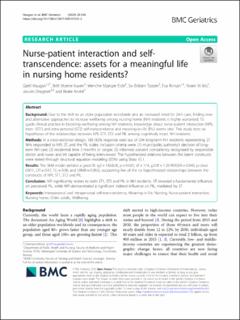| dc.description.abstract | Background
Due to the shift to an older population worldwide and an increased need for 24-h care, finding new and alternative approaches to increase wellbeing among nursing home (NH) residents is highly warranted. To guide clinical practice in boosting wellbeing among NH residents, knowledge about nurse-patient interaction (NPI), inter- (ST1) and intra-personal (ST2) self-transcendence and meaning-in-life (PIL) seems vital. This study tests six hypotheses of the relationships between NPI, ST1, ST2 and PIL among cognitively intact NH residents.
Methods
In a cross-sectional design, 188 (92% response rate) out of 204 long-term NH residents representing 27 NHs responded to NPI, ST, and the PIL scales. Inclusion criteria were: (1) municipality authority’s decision of long-term NH care; (2) residential time 3 months or longer; (3) informed consent competency recognized by responsible doctor and nurse; and (4) capable of being interviewed. The hypothesized relations between the latent constructs were tested through structural equation modeling (SEM) using Stata 15.1.
Results
The SEM-model yielded a good fit (χ2 = 146.824, p = 0.021, df = 114, χ2/df = 1.29 RMSEA = 0.040, p-close 0.811, CFI = 0.97, TLI = 0.96, and SRMR = 0.063), supporting five of the six hypothesized relationships between the constructs of NPI, ST1, ST2 and PIL.
Conclusion
NPI significantly relates to both ST1, ST2 and PIL in NH residents. ST revealed a fundamental influence on perceived PIL, while NPI demonstrated a significant indirect influence on PIL, mediated by ST. | en_US |

